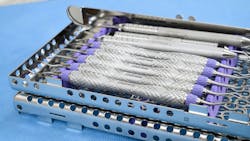Raising the standard: A hygienist’s journey with dental instrument cassettes
What you'll learn in this article
-
How instrument cassettes improve efficiency, organization, and safety in dental practices
-
The role cassettes play in enhancing patient confidence and infection control
-
Why cassettes simplify staff training and reduce long-term costs through durability and standardization
I first became familiar with cassette use during hygiene school and a work-study placement at a dental clinic, where I learned proper instrument reprocessing protocols. Following graduation, I often worked in offices where loose instruments were common, which sometimes felt inconsistent with the best practices I had been previously taught.
That changed upon joining my current practice in Atlanta. From the beginning, it was clear this office prioritized doing things the right way—not just to meet compliance standards, but because our practice owner demonstrates that he genuinely values patient safety and clinical excellence. In 2018, our practice grew from one doctor to four, and from a small hygiene team to currently five hygienists. With that expansion came more treatment rooms and a state-of-the-art sterilization center. It was at this time that we implemented IMS cassettes with the goal of improved organization, efficiency, and safety in our daily workflow.
The impact was immediate. Cassettes delivered on the order and consistency we needed for our instrument management, especially with the use of color-coding to identify the different procedures among our various clinicians. Instead of searching through bags for individual instruments, potentially sitting down and having something broken or even missing completely, I can simply grab the appropriate cassette, confident that everything I need is already inside.
Here are a few key benefits dental instrument cassettes have brought to our practice:
Patient recognition
Our patients notice. Particularly in the context of heightened awareness around infection prevention since COVID-19, presenting a wrapped, sterilized cassette sends a clear message to reinforce our commitment to safety and professionalism. While patients may not understand all the technical details, they can sense the quality of our patient care. On multiple occasions, I’ve received positive comments regarding the cleanliness and high-end appearance of our practice treatment rooms, which helps establish trust and confidence while in our care.
Simplified training
Cassettes have also streamlined training for new and temporary staff. When someone steps in to help with sterilization, I can easily guide them through our process in just a few minutes. Because the system is standardized, new team members do not need to guess the correct instruments for specific procedures or individual doctor preferences. The cassettes allow them to confidently step in and run the sterilization process from the very beginning.
Professional appearance
Our HuFriedyGroup cassettes still look as polished and professional as they did when we first purchased them. While I have seen other low-cost alternatives in different offices that did not withstand the test of time, our stainless steel cassettes have been durable and maintained their integrity to effectively protect our delicate instruments from damage and unnecessary wear. The benefit is cost savings for the practice.
If there is a question whether cassettes are space-consuming or cost-effective, I recommend scheduling a consultation to assess your current practice. An external evaluation could provide valuable insights into optimizing your instrument kits and practice storage solutions, leading to long-term savings through reduced instrument replacement, more efficient sterilization processes, and enhanced instrument safety practices for the clinical team—often outweighing the initial investment. After nearly three decades in hygiene, I can say with certainty that I can’t imagine ever going back to loose instruments in practice. Cassettes have raised standards in our practice, benefiting our team, our patients, and me.
Editor's note: This article appeared in the October 2025 print edition of RDH magazine. Dental hygienists in North America are eligible for a complimentary print subscription. Sign up here.
About the Author
Annette Davila, RDH
Annette Davila, RDH, earned her dental hygiene degree from Ferris State University and has spent more than 25 years educating patients on the connection between oral and overall health. Dedicated to lifelong learning, she stays current with advances in dental hygiene through continuing education and professional development. Known for her thorough, compassionate chairside manner, Annette values building lasting patient relationships. Outside of dentistry, she enjoys time with her husband, four children, and their Golden Retriever.
